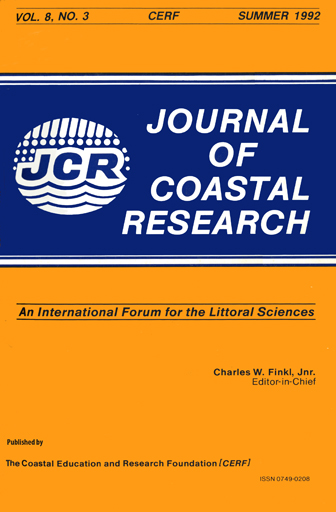Late Quaternary Evolution of the Northwestern Nile Delta between the Rosetta Promontory and Alexandria, Egypt
Keywords:
Abu Qir ridge, bay facies, Canopic branch, Idku lagoon, paleogeography, Rosetta promontory, sea level change, subsidenceAbstract
The northwestern Nile delta of Egypt between the Rosetta promontory and Abu Qir carbonate ridge is characterized by a concave coastline backed by the Idku lagoon, extensive coastal sand flats and dunes. The late Quaternary evolution of this region is interpreted primarily on the basis of petrological and faunal analyses of 22 radiocarbon-dated cores. The subsurface study reveals thin Holocene sections in the southern and western sectors, previously unrecognized marine bay facies in the western sector, thick vegetal-rich layers of marsh origin in the eastern sector, thick barrier beach sands in the northern sector, and thick fluvial-derived sands at the Rosetta promontory. Interpretation of subsurface sediment distribution and paleogeography takes into account natural factors that determine sediment distribution (eustatic sea level, subsidence, paleoclimate and sediment transport processes) and the impact of man.
The evolving configuration of this delta area during the past ~35,000 years is shown by a series of time-slice paleogeographic maps. These maps highlight the migration of the coastline, shifts of major channel systems and shrinkage of lagoons with time. Late Pleistocene to early Holocene sequences (~35,000 to 7,500 years BP) include mostly alluvial and shallow marine siliciclastic deposits. Holocene sequences (since ~7,500 years BP) include delta-front, marine bay, lagoon, marsh and delta plain facies. Accumulation rates, highest in the sand-rich Rosetta promontory, locally exceed 600 cm/1,000 yr. The study area, in contrast to the delta region to the east, comprises open marine bay deposits and thick peats (to 5 m), and records some emergence in the area south of Abu Qir ridge.
The positions and ages of the former major Nile distributary channels in this region are revealed by analysis of radiocarbon-dated cores. These include a large Pleistocene channel which extended just to the east of Abu Qir ridge into what is now Abu Qir bay and, perhaps, further onto the Egyptian shelf. During the Holocene, the north-flowing Canopic channel was first positioned along the western margin of Idku lagoon (~6,900-4,000 yr BP), then migrated westward to just east of Abu Qir ridge (~4,000-3,000 yr BP), and then shifted eastward to its former position along the western margin of Idku lagoon (~3,000-2,500 yr BP) where it has remained until recent time. It is postulated that erosion of the Canopic promontory in presently submerged western Abu Qir bay gave rise to large volumes of sands which formed coastal ridges, broad sand flats and coastal dunes along the northwestern delta. The Bolbitic-Rosetta distributary to the east is a younger system (from ~2,500 yr BP) that, during most of its history, has been modified by man. Shallow lagoons have prevailed in the study area, at least since ~5,000 yr BP, and have been increasingly subject to human influence. Abu Qir lagoon, still in existence 200 years ago, has completely disappeared. The larger ldku lagoon is reduced to only 20% of its original size, as a function of reduced fresh water flow to the coast, land reclamation and irrigation projects. This study calls attention to the need to protect these natural habitats which are vital to man in the Nile delta.


